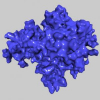Free Online Productivity Tools
i2Speak
i2Symbol
i2OCR
iTex2Img
iWeb2Print
iWeb2Shot
i2Type
iPdf2Split
iPdf2Merge
i2Bopomofo
i2Arabic
i2Style
i2Image
i2PDF
iLatex2Rtf
Sci2ools
VIS
2004
IEEE
2004
IEEE
Rough Interface Reconstruction Using the Level Set Method
We present a new level set method for reconstructing interfaces from point aggregations. Although level-set-based methods are advantageous because they can handle complicated topologies and noisy data, most tend to smooth the inherent roughness of the original data. Our objective is to enhance the quality of a reconstructed surface by preserving certain roughness-related characteristics of the original dataset. Our formulation employs the total variation of the surface as a roughness measure. The algorithm consists of two steps: a roughness-capturing flow and a roughness-preserving flow. The roughness capturing step attempts to construct a surface for which the original roughness is captured ? distance flow is well suited for roughness capturing. Surface reconstruction is enhanced by using a total variation preserving (TVP) scheme for the roughness-preserving flow. The shock filter formulation of Osher and Rudin is exploited to achieve this goal. In practice, we have found that better...
| Added | 05 Nov 2009 |
| Updated | 05 Nov 2009 |
| Type | Conference |
| Year | 2004 |
| Where | VIS |
| Authors | David Thompson, Raghu Machiraju, Yootai Kim |
Comments (0)

